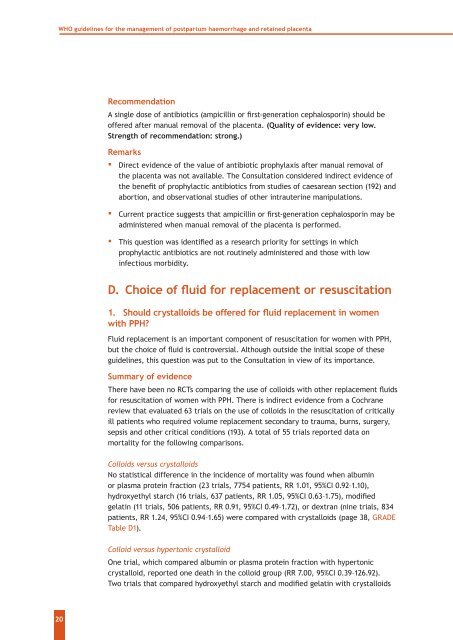WHO guidelines for the management of postpartum haemorrhage ...
WHO guidelines for the management of postpartum haemorrhage ...
WHO guidelines for the management of postpartum haemorrhage ...
You also want an ePaper? Increase the reach of your titles
YUMPU automatically turns print PDFs into web optimized ePapers that Google loves.
<strong>WHO</strong> <strong>guidelines</strong> <strong>for</strong> <strong>the</strong> <strong>management</strong> <strong>of</strong> <strong>postpartum</strong> <strong>haemorrhage</strong> and retained placenta<br />
Recommendation<br />
A single dose <strong>of</strong> antibiotics (ampicillin or first-generation cephalosporin) should be<br />
<strong>of</strong>fered after manual removal <strong>of</strong> <strong>the</strong> placenta. (Quality <strong>of</strong> evidence: very low.<br />
Strength <strong>of</strong> recommendation: strong.)<br />
Remarks<br />
▪ Direct evidence <strong>of</strong> <strong>the</strong> value <strong>of</strong> antibiotic prophylaxis after manual removal <strong>of</strong><br />
<strong>the</strong> placenta was not available. The Consultation considered indirect evidence <strong>of</strong><br />
<strong>the</strong> benefit <strong>of</strong> prophylactic antibiotics from studies <strong>of</strong> caesarean section (192) and<br />
abortion, and observational studies <strong>of</strong> o<strong>the</strong>r intrauterine manipulations.<br />
▪ Current practice suggests that ampicillin or first-generation cephalosporin may be<br />
administered when manual removal <strong>of</strong> <strong>the</strong> placenta is per<strong>for</strong>med.<br />
▪ This question was identified as a research priority <strong>for</strong> settings in which<br />
prophylactic antibiotics are not routinely administered and those with low<br />
infectious morbidity.<br />
D. Choice <strong>of</strong> fluid <strong>for</strong> replacement or resuscitation<br />
1. Should crystalloids be <strong>of</strong>fered <strong>for</strong> fluid replacement in women<br />
with PPH?<br />
Fluid replacement is an important component <strong>of</strong> resuscitation <strong>for</strong> women with PPH,<br />
but <strong>the</strong> choice <strong>of</strong> fluid is controversial. Although outside <strong>the</strong> initial scope <strong>of</strong> <strong>the</strong>se<br />
<strong>guidelines</strong>, this question was put to <strong>the</strong> Consultation in view <strong>of</strong> its importance.<br />
Summary <strong>of</strong> evidence<br />
There have been no RCTs comparing <strong>the</strong> use <strong>of</strong> colloids with o<strong>the</strong>r replacement fluids<br />
<strong>for</strong> resuscitation <strong>of</strong> women with PPH. There is indirect evidence from a Cochrane<br />
review that evaluated 63 trials on <strong>the</strong> use <strong>of</strong> colloids in <strong>the</strong> resuscitation <strong>of</strong> critically<br />
ill patients who required volume replacement secondary to trauma, burns, surgery,<br />
sepsis and o<strong>the</strong>r critical conditions (193). A total <strong>of</strong> 55 trials reported data on<br />
mortality <strong>for</strong> <strong>the</strong> following comparisons.<br />
Colloids versus crystalloids<br />
No statistical difference in <strong>the</strong> incidence <strong>of</strong> mortality was found when albumin<br />
or plasma protein fraction (23 trials, 7754 patients, RR 1.01, 95%CI 0.92–1.10),<br />
hydroxyethyl starch (16 trials, 637 patients, RR 1.05, 95%CI 0.63–1.75), modified<br />
gelatin (11 trials, 506 patients, RR 0.91, 95%CI 0.49–1.72), or dextran (nine trials, 834<br />
patients, RR 1.24, 95%CI 0.94–1.65) were compared with crystalloids (page 38, GRADE<br />
Table D1).<br />
Colloid versus hypertonic crystalloid<br />
One trial, which compared albumin or plasma protein fraction with hypertonic<br />
crystalloid, reported one death in <strong>the</strong> colloid group (RR 7.00, 95%CI 0.39–126.92).<br />
Two trials that compared hydroxyethyl starch and modified gelatin with crystalloids<br />
20
















